Ellen and Jim Have a Blog, Too
We are two part-time academics. Ellen teaches in the English department and Jim in the IT program at George Mason University.


Simon Raven's _Pallisers_ 1:1: The Coerced Match · 4 August 07
Dear Marianne,
While away I read Michael Barber’s excellent biography of Simon Raven. Just before we left I had finished the whole 26 part series, and had watched Volume One, Part One so carefully, that I basically took down the screenplay. On the most general level, David Cannadine’s Decline and Fall of the British Aristocracy will help explain the Palliser films which are done (I submit) in the teeth of this decline and fall. Raven thought at whatever personal sacrifice the experience Talleyrand so memorably described as the ancient regime before the 1790s was worth it.
This letter will be the first of 26 preliminary sketches for parts of chapters on a book whose working title is The Palliser Film Series. The obstacle is each part seems to me so generally brillant and finely nuanced in details, plus interesting as a reflection of the era’s perceived social arrangements, that I don’t know where to begin. As in the case of Whit Stillman’s free adaptations of Jane Austen’s books, the matter seems too complicated even to broach in a blog, no matter how intendedly simple. Still this device of pre-writing, working out one’s thoughts, will be enormously helpful the day (year?) I finally sit down to write a long book on this series as a whole.
Retitling some of the major divisions can help us see the distance between the work and Trollope’s novels. For example, Volume I, Part I, is about a coerced match. Neither heroine, Lady Glencora McClusky (Susan Hampshire) or Alice Vavasour (Caroline Mortimer) does anything wrong in any way we must forgive her for. Indeed we watch “the little McClusky” as the Duke of Omnium (Roland Culver) calls her, turning her into a thing, be deeply violated in her heart, harassed and her mind polluted by ugly stories, threats of a future to come, and insinuations she can marry whom she please and commit adultery on the side. We hear that Alice was sexually betrayed by her cousin, George (Gary Watkins) whom she was engaged to; the hurt remains intense.
“The coerced match” is structured around two stories, and Alice’s isn’t one of them. Hers is on the margins and is part of the reason she refuses to help Lady Glencora meet Burgo Fitzgerald (Barry Justice) whom Lady Glen loves or is at least deeply attracted to. The two stores are Lady Glen’s and Plantangenet Palliser’s (Philip Latham plays this part superlatively well). Lady Glen and Plantagenet Palliser, presented as two young innocent and sincere (the former does not in Raven’s world exist without the latter) adults, are both ruthlessly bullied and threatened into marrying one another, as they see this, someone for whom there is no congenial basis to get together.
The parallel love story for Plantangenet Palliser is created by changing the character of Trollope’s Griselda, Lady Dumbello (Rachel Herbert). Raven’s Griselda appears really to appreciate Plantagenet’s earnest intellect, and if she is pretending to care about decimal coinage, she is attracted to his open non-aggressive stance, his gentlemanly ways, his whole stance. He (poor man) is seen as alone at the large garden party the Duke is giving (and where the series opens) yearns for someone as idealistic and serious as he. Griselda is however married. Burgo is more compromised because his character is at issue: he drinks heavily, gambles, is in debt, and may want to marry Lady Glen for her money more than what she is, but it is clear he is intensely desperately in love with her.
Here are two parallel stills for the two pairs of lovers. The first pair seen first in a gentle picturesque moment (there are many such) at the garden party:
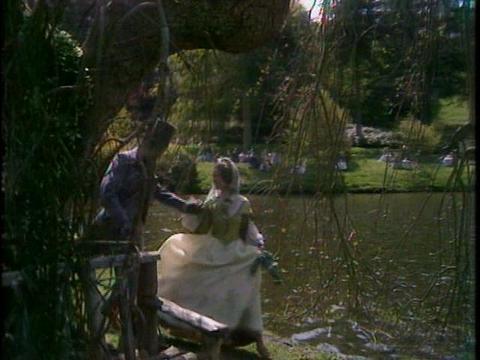
Griselda, Lady Dumbello (Rachel Herbert) and Plantagenet Palliser (Philip Latham)
The real passion of the second pair is brought out by close-ups where they hide within the green world
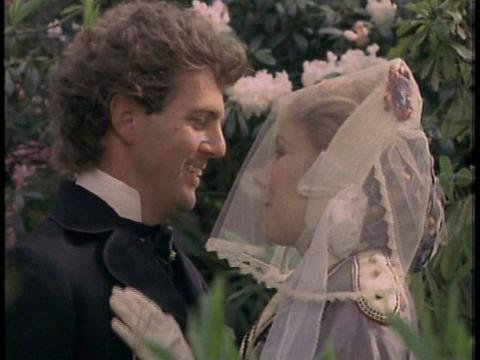
Lady Glencora McClusky (Susan Hampshire) and Burgo Fitzgerald (Barry Justice)
Films are not supersubtle in their outlines: the corrupt heartless faithless drone, the Duke of Omnium (Roland Culver), with the help of the narrow-minded, foul-minded, over-prudential, materialistic aunts of Lady Glencora, Charlotte, Countess of Midlothian (Fabia Drake), and Adelaide, Marchioness of Auld Reekie (Sonia Dresdel), engineer the match.
The plot-design may be read thematically this way: we have two sets of guardians (Lady Glen’s aunts, Plantagenet’s uncle) who stand up for the establishment, the status quo where the norm is to live your life to get money and luxury, and remain in your clique. Those who adhere to this standard include those who don’t bother justify this as it seems self-evident what matters is material comfort and power (whether for safety or to inflict your will on others no matter):
there are the corrupt ones, the Duke and the leering fearful puritans, Adelaide, Lady Auld-Reekie, and Charlotte, Countess of Midlothian; then less powerful George Vavasour;
there are the moralizing ones, Alice Vavasour is part of these (later Madame Max will be from a prudential angle).
Against this we have our hero and heroine, the coerced pair, Plantagenet Palliser and Lady Glencora McClusky who are presented as sincere, with real depths of feeling and ideas (even Lady Glencora has glimmerings of ideas although inarticulate).
The two they are attracted to intensely are rendered suspect: Burgo Fitzgerald’s relationship with George Vavasour and desperate need of money (gambling, drink) makes for a desperate type who is not to be depended upon, someone who could be shattered (we see glimpses of this already); Griselda Lady Dumbello’s insinuating agreement through implication to adultery or teasing games of sex marks her out as not quite meaning it, even if she alone in the episode looks up to Planagenet and seems to have some sympathy and understanding for his yearning idealism (as we said months ago when I first wrote about this episode, this woman character is not Trollope’s Griselda, Lady Dumbello (nee Grantly). There are the instruments like Fothergill, Dolly Longestaffe is our cynical but candid chorus.
Against this scrim, different though they are in gut impulses and developed character to the point they both show an immediate distaste for one another, both Plantagenet Palliser and Lady Glencora McClusky emerge as sensitive and decent, not corrupt and if not against the morality, not necessarily upholding it. Indifferent to social conformity when it is insincere, corrupting, inimical to deepest desires of love.
Much of this first part is sheer invention on Raven’s part and derives from a few chapters in Dr Thorne and The Small House at Allington (the third and fifth of the Barsetshire novels), and and opening episodes of Can You Forgive Her? (the 1st of the Palliser novels). This is where Raven took his Duke of Omnium, the Duke’s secretary, Fothergill (John Nettleton), his nephew, Plantagenet Palliser; the young married woman Plantagenet is attracted to, Griselda, Lady Dumbello (nee Grantly, much changed); the fantastically wealthy Lady Glencora McClusky engaged to the ne’er-do-well, Burgo Fitzgerald in The Small House and we are told the match was broken off and she pressured intensely into marrying Plantagenet Palliser. Some material comes from Can You Forgive Her?: the broken engagement of Alice (Caroline Mortimer) and George Vavasour (Gary Watson). The reasons for her breaking off are brought out later in the book, and she is blamed by Trollope.
An interesting addition wholly from elsewhere is the cynical character of Dolly Longstaffe (Donald Pickering) first seen in Trollope’s The Way We Live Now and brought back in his The Duke’s Children (the 6th Palliser novel).
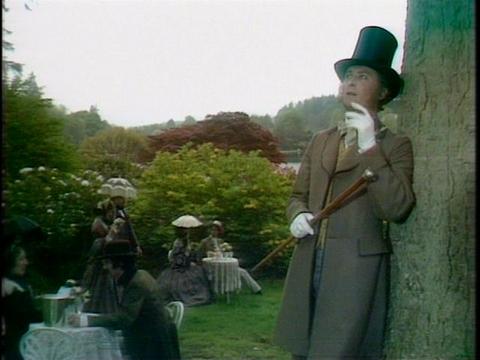
Dolly Longstaffe (George Pickering) looking on
He is introduced third, right after Plantagenet and Lady Glen. This reveals his importance for Raven. He acts as a kind of disillusioned chorus for much of the series, retelling what has occurred in a previous episode, framing for the audience what we are seeing now with motivations for the characters we watch that are consistently selfish, materialistic, manipulative and often anti-humanistic.
I do very much dislike Raven’s transformation of Alice into at too many moments a sort of grim prig, a guardian of convention who longs for a violent sexy man (this is a crude misogynistic development of a theme in Trollope’s text), and also John Grey into simply a dullard. Anyone who reads is dull? This aspect of Alice and Grey’s romance reduces and mars this opening part, and slurs Plantagenet (who is paralleled to Grey as he is in Trollope) too. However, there are better moments:
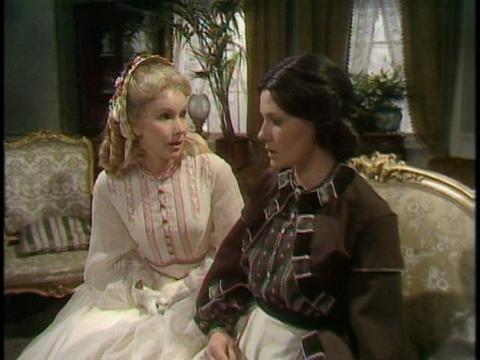
Alice (Caroline Mortimer) remembering how she was betrayed while Lady Glen (Susan Hampshire) asks for her to involve herself in similar painful events on Lady Glen’s behalf
I noted superfluous cynicism and salacious undercurrents in this first part too: as when Planty tells Lady Griselda of his decimal system as a “climax” and we are to laugh at them because they are too weak to have sex but rather carry on this absurd sublimated conversation. With the exception of some of the material from The Eustace Diamonds, in the later episodes Raven and the team took all the characters more seriously and did not deprive them of an imagined burden of human reality. Later on Lord Fawn (Derek Jacobi) is treated as a figure of fun and sneered at as effeminate; some slapstick occurs. Here Griselda and Plantagenet are deprived of their otherwise poignant condition. Griselda plays a parallel role to Alice: she is unable to rebel against all those who surround her though she would like to; we feel that Plantagenet might or could have could he have found but one person to stick to him. He found none—or one could say the only person he found to look him in the eyes with sincerity was Lady Glen when he puts the ring on her finger.
From Michael Barber’s excellent life of Simon Raven, The Captain, I discovered my sense that the character of Dolly Longestaffe was modelled on Addison from All About Eve as played by George Saunders has some proof. Barber says Simon Raven wrote that he admired the actor George Saunders very much and especially the types he played: the cynical man-about-town male, the “suave cad.” Immediately after we are introduced to the principals across the series (the young Palliser and young Lady Glen), the next in line is Dolly Longestaffe. He and George Vavasour are chorus: they fill us in on previous history (ironically in the context of the film); they make the various characters’ alibis and personalities transparent to us.
The part divides into 5 episodes, and within these there is much parallelism and contrast. The work is very artful.
Episode 1: Plantagenet’s friend is Griselda, Lady Dumbello. The scenes between Plantagenet and Griselda are sandwiched in between scenes of the Duke offering Plantangenet much money and favor and scenes of George Vavasour and Dolly Longstaffe talking about them and also Glencora and Burgo.
Episode 2: Glencora and Burgo. Their story is presented marvellously effectively as a sort of dance. Waltz music plays throughout and we watch the young pair waltz. We can see their love affair can hardly continue as their scenes are juxtaposed byo two sets of choral conversations filling us in and setting the framework: again George Vavasour and Dolly Longstaffe; and the hard mean pair of aunts (presented I’m afraid as harpies in black), Adelaide, Marchioness of Auld-Reekie and Charlotte, Countess of Midlothian on the other. The minds of these two women are presented as a sink of filth: at one point one suggests another man for Glencora; they whipser leeringly into one another’s ears and decide, well no. The attitude towards sex in this pair is vile.
Episode 3: The Duke’s wishes. The Duke is against Plantagenet’s possible liaison with Griselda, Lady Dumbello because (it’s hinted) he, the Duke, had an affair with Lord Dumbello’s mother, Lady Hartletop. (In The Small House Trollope hints that Lord Dumbello is the Duke’s illegitimate son.) This episodes climaxes on the Duke’s secretary Fothergill warning Plantagenet that if he displeases the Duke he, Plantagenet, could lose all the favors and heaps of money the Duke is ready to bestow on him. The series suggested why the woman is confrontationally bullied: in a sense that’s all Lady Glencora’s aunts have is intense harassment and overt personal bullying and cruel comments; the Duke behaves far more respectfully to his nephew, but he has far more ultimate effective weapons since Plantagenet wants to have an effective role in public life.
Episode 4: Going to Alice’s. Alice Vavasour is brought in and this time by going very slowly I could see the film-makers meant us to see that her failure to help Lady Glencora (as Lady Dumbello fails Plantagenet) is partly the product of her own sexual betrayal by George.
Episode 5: The engagement. Through an extraordinary series of tracking shots we watch Plantagenet and his uncle walking through a series of trees from one end of a park, and Lady Glencora walking with her aunt through another. They walk very slowly. When they reach the clearing, the young couple must walk to one another and then plight their troth. It is an unforgettable theatrical ring scene sandwiched between the corruption of the aunts and uncles as both sets counsell adultery.
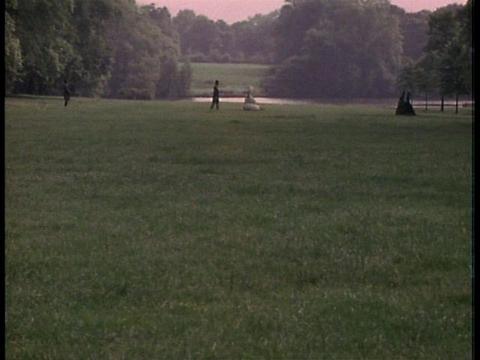
They come closer and closer until they stand face to face:
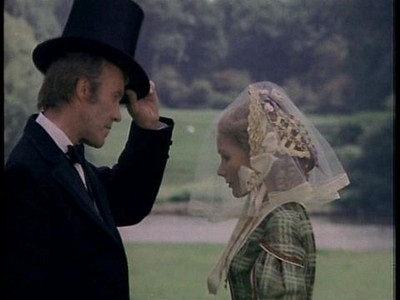
Then she looks up, hoping for some genuine honest kind face, her face open to his:
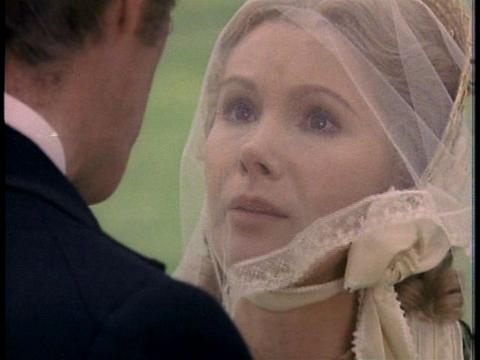
He pities her:
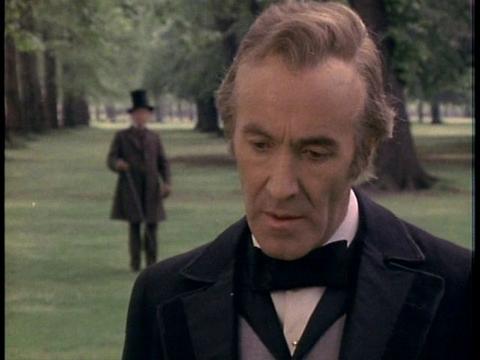
We see he can be kind and she can yield; both have shown some part of their natures which will allow them to trust and respect one another in life.
Before and after it we see the uncle and aunts suggest to the two they can always commit adultery: Lady Glen puts her hands over her ears; Plantagenet talks of the importance of love in marriage, and says in no uncertain terms he means to be sexually and emotionally faithful to his vows.
The way the marriage is expressed is wholly expressionistic and unrealistic: the two forced to walk up to one another with the archetypal corrupt older figures forcing it; their dialogue the one they speak in CYFG after Plantagenet has taken Lady Glen away to Europe and she has told him she loves Burgo and wants to flee him.
The series is going to plot a series of transformations of cultural values from this enforced cruel moment to one of generosity on the part of parents. Among the most interesting scenes are those where we see the hero and heroine react to those who thwart them. For example, when Lady Glencora interact with Alice, Lady Glen begs Alice to help her, but while helping her seems primarily to mean Alice should enable her to meet with Burgo, it also (in a single line though) seems to mean she would like to break with Burgo and secure for herself a good, stable, prudent man, if not necessarily Plantagenet Palliser. When Plantagenet finds himself in a room with the Duke and Griselda, Lady Dumbello and the Duke says they must break up, Plantagenet has the courage to turn to Griselda to attempt to get her to speak aloud what he thought was her love for him; she turns away and with a petty gesture, says never, never Griselda to you, and the hurt in his face is profound.
This first part (Volume 1, Part 1) contrasts with the twenty-sixth or last in the whole series (Volume 3, Part 26). In this first we have two young people ruthlessly coerced into a marriage neither wants to people neither even knows. In the last the Duke, however reluctantly and then gladly, and the Duchess in her dying moment, rescind and reject this older way and give the young people, Silverbridge (Anthony Andrews) and Lady Mary Palliser (Kate Nicholls) their choice. The young pair do stand out, but then they knew they could; that they would not be punished for the rest of their lives materialistically and emotionally for their choices. In this first episode the young Planty puts a ring on the hand of the intensely reluctant Lady Glen who at that moment tells him she loves another (to which he says she must erase the man and love him now); that very ring is the ring the aging Duke puts on the hand of Isabel Boncassen (Lynne Frederick). As Dolly looked out cynically to the left in episode one, to look up at the powerful Duke, and the wealthy apparently Arcadian morning and afternoon scene lit by the sun before him, so Lady Mary Palliser, the lovely daughter of Lady Glen and Plantagenet Palliser, now all grown up, looks out to the right to her mother’s grave at Matching Priory. The Duke watches her from his window nearby, from which he too can see the grave. Dolly was all supercilious performance and disillusion, Mary all sincerity and earnest idealism:
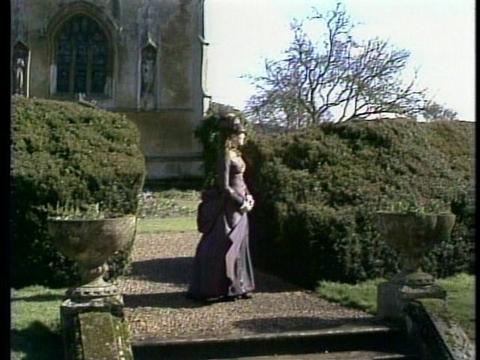
Lady Mary Palliser (Kate Nicholls) seen by her father looking out at the grave of her mother one autumn afternoon
We are to assume the film Duke of Omnium (as Philip Latham now is) has long forgotten that scene; the ring in the film series become a symbol of faithful love and companionship. (In Trollope’s novel, The Duke’s Children, we see the Duke and Duchess to their dying day remained at odds, their marriage a continually painful as well as supportive relationship.) Amid a fine day in the landscape of this first episode the Duchess of Omnium (as Susan Hampshire has become) is first seen putting a flower in the button hole of a jacket of Burgo; amid a fine day late in the series (Volume 3, Part 24), she is seen in the landscape of Matching, putting a flower in the button hole of the Duke.
The general story line from Trollope’s novels (the hinge-turning points of Trollope’s stories) are kept, and some of the part is a development out of suggestions in Trollope’s, but many new episodes are invented (though interesting one kept is Griselda’s mother’s letter to her), and the characters transformed in accordance with film conventions. The film-makers turn Plantagenet into a character parallel to Lady Glen. Both in love probably with people they would probably not be happy with in the long run (anyway Griselda is married so it would have to be adultery), but whom they are drawn to and perhaps could have been happier with than they are eventually with one another in Trollope’s books. In the films the pair learn to love, esteem, trust and be everything true that human nature will allow to one another, no matter how different many of their first gut impulses and even behavior.
Archetypally the folk way of showing a couple falling in love inevitably is to begin with antagonism and end on them getting together. The films exploit this simplistic myth. It lies behind Austen’s treatment of Darcy and Elizabeth Bennet in Pride and Prejudice.
There are fascinating similarities in this (and other parts in these films) with other film adaptations: the opening scene of Burgo chasing Lady Glen around a bush is precisely the opening scene of the recent film HKHWR; as in Austen adaptations, characters and events and lines from other novels by the same are taken over for this: so the second scene in this Palliser 1 introduces to the cynical disillusioned sceptic Dolly Longestaffe as he appears in TWWLN and the personality of Dolly is taken from Raven’s appreciation of George Saunders’ performances, partly as Addison.
I’ve come to the conclusion the Palliser films are a great work of
televisual art in the classic film mini-series adaptation mode. The first comes almost immediately upon the credits: we see an picturesque Arcadia which exemplifies all that Inglis argues is central to the 1970s film adaptations of classic novels. My qualification of his thesis is the qualities he describes exemplify the TV and cinema faithful film adaptation from the 1970s through the culmination of the subgenre in the mid-1990s to early 2000s.
The figures are playing croquet and we hear music which captures the light frivolity of the game: For after all who cares who wins? The point is to pass time pleasurably. Then the camera pans out and we see the larger picture: bridge, temple in the distance, classical statue of a nymph, a lady from the back the 19th century representation of this earlier archetype.
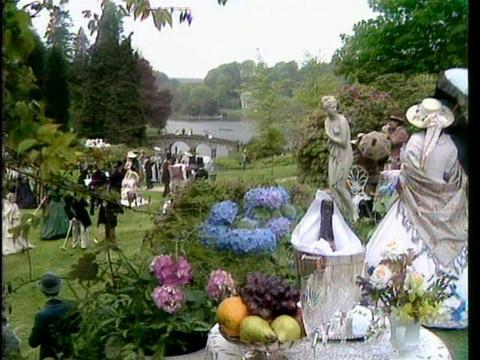
And then the hero of the piece glimpsed walking along the bridge.
He is headed for his interview with the powerful male who controls
the scene, the present Duke of Omnium.
Halycon moments. The palette of this part is made up of hues of green, a light pink pervades the sky.
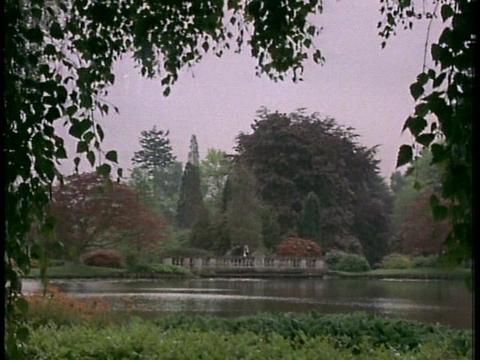
Sucn heart-stopping beauty may be what the series suggests is compensation for selling your body and soul.
Elinor
--
Posted by: Ellen
* * *
Comment
- From Austen-l,
“Ellen, I remember this mini-series very well and with great affection: our family watched it together on PBS when it first came out, and my parents and I watched the DVDs together two years ago—it was the last real joint viewing of things that my mother was able to engage in before she passed away in 2005. It is also my favorite of the older BBC mini-sereis along with I Claudius. I will say that it was an important preparation for my experience of Victorian literature, and that when I came to read Trollope’s series, the adaptations and liberties didn’t bother me and made sense within the scope of the mini-series, including and especially Dolly’s presence throughout, and looking like The New Yorker’s Eustace Tilley. Some very powerful moments, especially the episode dealing with the aftermath of Phineas’ trial wherein Philip Latham’s Plantagenet delivers a beautifully-written and wonderfully spoken monologue which stayed with me a very long time. After reading the actual series, I felt that Trollope would, for the most part, give his blessing to this massive and memorable project.
Looking forward to reading all of your entries on the mini-series.
Maria
elena@pipeline.com
(forgive any typos: I have a gray tabby blocking the monitor and
looking for affection).”
— Elinor Aug 5, 6:32am # - I have re-watched Episode 1 carefully trying to take notes in order to be able to add a commentary to Ellen’s analysis (even though I am far from completing my first view through!).
The following does not make much sense in itself and is intended either to note things which I found significant or to comment on Ellen’s brilliant essay which is complete in itself.
I use ‘Raven’ throughout as a shorthand for the production team.
The opening scenes portray a highly desirable life – croquet, boating, wine, music, a gorgeous landscape. The first shot of Palliser (as I shall call Plantagenet) is of him walking alone (as Ellen has noted) through the crowd all of whom are either in couples or larger groups. He is dressed sombrely in light grey. He is thus set apart, presented as serious, before even a word has been spoken. He passes by Glencora and Burgo who are playing in a highly flirtatious way – but playing, Glencora is innocent, natural, even to some extent already infantilised?.
The Duke sits on high in absurd state. He instantly manifests a highly developed cynicism; he ‘takes no pleasure’ in this social whirl but must do it to fulfil his obligations. it ‘lets the thing go on’. He gives Palliser another £2000 a year and says he should get married. Palliser says ‘Your Grace is very good’ and Omnium replies ‘no I simply know how things ought to be done’. This might be description of the whole episode which is about differing visions of how things ‘ought to be done’.
Dolly is introduced as our guide and narrator. He explains to George (who is instantly marked out by his scar, his loud trousers and the fact that he ogles at women – the language of costume is not subtle in this episode) that Palliser is a an odd fish because he doesn’t ‘shoot, hunt, bet, smoke, drink’ indeed hardly eats and of course takes no interest in women. A definition of masculinity is thus introduced. Of course Palliser then astounds him by very obviously pursuing the transformed Griselda. I find the transformed Griselda highly unsatisfactory because I cannot understand how Raven means us to read her, or Palliser’s view of her. It appears in this first scene that she is genuinely interested in the decimal scheme and it is this which attracts Palliser.
We then have Glencora’s guardians. This time it instantly struck methat Raven meant the audience to read these women as representations of Victoria. The clothes are exactly those which fit the popular conception of Victoria – widow’s weeds. So they represent Victoria – or more accurately the popular idea of Victoria in the 970’s (the ‘real’ Victoria is an irrelevance). And Raven is sending up that idea – hardly radical at the time – by showing them as complete hypocrites (which chimes with popular conceptions of the ‘Victorian’ age). He introduces one of those lines which strike me as Wildean ‘no man is entirely respectable’ – now it may be this line is in Trollope, but it is delivered in a very Lady Bracknell way. They discuss Burgo Fitzgerald and his claim to be descended from Richard 1st – one says only on the wrong side of a lot of blankets. I guess Raven is making a joke about the Fitz – which of course indicates bastardy – maybe this was in Trollope’s mind when he invented the name?
The opening scene continues to flow beautifully in its own way – Glencora and Burgo literally bump into Palliser and Griselda and it is this which provides the idea(of marrying Glencora off to Palliser) to the Victorias. Of course this is not in Trollope but it seems to me a wonderful notion of aven’s which works perfectly in a visual way.
Finally the Victorias approach Omnium with their idea of matching Glencora and Palliser and after a pause he gives his consent – there is an abrupt cut and the music (literally) ends – the decision has been made.
The characterisation of Griselda continues to be problematic. We have a small scene, with voice-over, of her reading her mother’s letter. She is seen in a mirror, and ends popping a sweet in her mouth. It is exactly as one would film the scene if one were filming Trollope’s Griselda – highly artificial (the mirror), amusedly cynical and calculating. But Raven’s Griselda would surely be genuinely upset by this letter? Perhaps this scene is like a small in-joke for real Trollope fans? It does not after all matter much in the larger scheme of the television series because Griselda will soon disappear. But it may be that sometimes we have to watch for small inconsistencies which are Raven’s nods to the Trollope fans (a small section of his target audience after all).
One device which Raven uses to great effect here (and I know is repeated at least once somewhere later!) is in the editing. When Glencora is repulsed by Alice’s she flees out of her door and the immediately succeeding shot is of her being pursued through another door by the Victorias. The effect is that we feel as though she has run out of Alice’s door immediately into the next one (though they are of course in fact physically far separate) and we link her failure at Alice’s, to her persecution by the Victorias, to get a sense of the pressure which leads to her compliance with their demands. The Victorias rub our nose in the regal connection by telling Glencora ‘the queen will not receive you’ before explaining how she will be able to easily fool Palliser and commit adultery once they are married.
After it the match is agreed Omnium doles out the goodies to Palliser – Matching, money, railway and mining stock, Glencora will get jewels and a carriage. Palliser talks of love. Love is for ploughboys says the Duke. The code of the Pallisers – what ‘ought to be done’ – has no place for such concepts.
Or indeed for the marriage vows – ‘words’. What matters are money, status, heirs.
We end with a shot of Glencora weeping behind the banisters/bars. Her prison awaits – or that is the shot’s implication here.
— Nick Aug 8, 2:49pm #
commenting closed for this article
